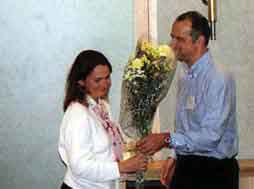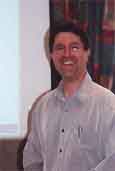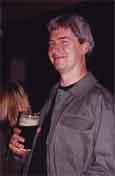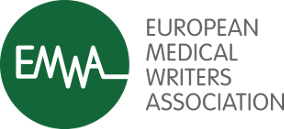History of EMWA (1992 - 2008)
 The history of EMWA: personal and possibly unreliable recollections
The history of EMWA: personal and possibly unreliable recollections
by Geoff Hall
Sitting down to write the history of EMWA reminds me of Tolstoy’s comment on historians that they are like deaf people who go on answering questions that no-one has asked. My feeling is that EMWA’s members are likely to be more concerned with the future of the association than its past. Nevertheless, in case there are a few people who are inwardly curious about the how, why, and in particular the when of EMWA, here goes. I tell a tale of flirtation, marriage, divorce, remarriage, betrayal and separation—and that’s just the relationship between EMWA and its American cousin, the American Medical Writers Association (AMWA).
But let’s start at the beginning, or before the beginning. My researches uncover a succession of meetings that took place before the generally recognised first meeting of EMWA in Brussels in February 1992. The initial idea grew out of an informal lunch enjoyed by Mike Matthews and Stephen de Looze in London after they had bumped into each other at the San Francisco AMWA meeting in 1986. There followed a meeting at the Alderley Park HQ of Zeneca between Stephen, Mike, Brenda Moore and others on 11 October 1990. Next, 14 individuals from 9 European-based pharma companies met at the Quorn Grange Hotel in Loughborough in the English East Midlands. Mike Matthews recalls, “There was a subsequent ‘pre-Brussels’ informal meeting somewhere in Belgium (Rixensart?) with the SmithKline vaccines crew, who were then key in carrying the whole thing forward.”
Two individuals at SK Biologicals deserve the credit for taking the whole thing forward: Jane Wynen—like so many important characters in the history of EMWA, an American based in Europe—and Ceara Roche. Ceara’s daughter Moya was born in April 1993 and she returned to her native Ireland. When EMWA came to Dublin in 2000 we were delighted to honour Ceara’s contribution.
 Ceara Roche, an honoured visitor to the 2000 conference in Dublin is presented with a token of EMWA’s appreciation by another of the key figures in EMWA’s history, Mike Matthews.
Ceara Roche, an honoured visitor to the 2000 conference in Dublin is presented with a token of EMWA’s appreciation by another of the key figures in EMWA’s history, Mike Matthews.
The SK Biologicals connection is how I came to be involved. The advertising/PR group that I worked for was involved in the pre-launch creative stuff for the world’s first hepatitis A vaccine. In addition to the marketing people, I met and worked with SK Biologicals’ remarkable medical director Francis André and his team.
A key member of this group, whom I had met at various meetings, Anne Hepburn, phoned from Rixensart to tell me about a meeting in Brussels for medical writers. Do you know, I don’t think I had ever previously heard the term medical writer? I was a writer who wrote about medicine— as well as other technical and non-technical topics. Still, I was intrigued by the idea of meeting people whose daily life posed many of the same problems that faced me. Writing is the most solitary of professions. Anne had said she wanted me to attend because I was a writer first and a scientist second (or even third) and so would offer a different perspective from most of the others attending.
Aaron Bernstein, the second EMWA president (1993) reported in AMWA Journal Europe (subtitled The Newsletter from the European Medical Writers Association Chapter of the American Medical Writers Association), “The European Medical Writers Association met formally for the first time in Brussels, Belgium, on 21 February 1992. A total of 32 persons from seven countries attended this meeting with a view to form a permanent writers’ group in Europe.” There were no workshops— you could have squeezed the whole lot of us into one—but, although the main point of the meeting was planning for the future, there was a programme that included a presentation from Helen Frampton on the role of a medical writer in Hoechst and Art Gertel (whatever became of him?) who described keys to improved reviewability of regulatory documents.
 Aaron Bernstein, EMWA’s second president is now based back in the US. He is a frequent visitor to EMWA meetings and a workshop leader.
Aaron Bernstein, EMWA’s second president is now based back in the US. He is a frequent visitor to EMWA meetings and a workshop leader.
The rest of the day was given over to discussing the creation and structure of EMWA. Should we be affiliated with AMWA? Should we model our meetings and constitution on AMWA? We resolved that we would be a chapter of AMWA, the idea being that we could make use of AMWA’s established structure and administration to help us get established. The vote was 24 to 5. The AMWA Board of Directors approved the formation of the chapter in March 1993.
Eindhoven in the Netherlands hosted the second meeting. The single day was filled with 3 one-and-a-half hour seminars and EMWA’s first 3-hour workshop, entitled ‘Writing Abstracts’ and delivered by an AMWA past-president Howard Smith. The seminars were ‘Globalizing Clinical Research Reports’ (Chris Preston, Hoffmann-La Roche, Basel), ‘Illustrations for Scientific Publications’ (Anthony Bowley ABCommunications, Switzerland—a helpful guide to the perennial poser of when to use graph, table or text) and ‘An Overview of Statistical Errors in the Medical Literature’ (James DeMuth, University of Wisconsin, Madison). This last remains one of the best talks on statistics I have ever heard.
The Bruges conference in March 1995 was an important milestone. It was the first conference with a programme of workshops—OK so there were only 4, but it was a start— and it was the scene of one of EMWA’s few rows (over our relationship with AMWA, of course).
The EC presented the agenda for the business meeting in a bulky folder. First up was an overview of membership and finances by Philip Cooper. (No longer involved in EMWA, Philip played a vital role in EMWA’s early years as our longserving and long-suffering treasurer. A genuine unsung EMWA hero.) Philip reported that we had 149 members, 51 more than the previous year, and SFr 18,000 in the bank— about USD 8,600/GBP 5,440/EUR 6,620 at that time.
Item 3 was the tricky one—the future of AMWA and EMWA. Members were to vote on whether or not to continue as a chapter of AMWA. The case in favour consisted of continuing to benefit from AMWA’s greater infrastructure and experience. The case against was primarily the exorbitant costs of affiliation (85% of the membership dues were paid to AMWA) and the reluctance of AMWA to allow workshops run in Europe to count for AMWA accreditation. EMWA could not offer accredited workshops with local workshop leaders without a lengthy, (some might say tortuous), approval process for both the workshop leader and the workshop content, including attending the AMWA yearly conference to deliver the workshops. There were other issues, of course, as having members on another continent required a flexibility that AMWA simply was not prepared to accommodate. For example, the conference registration forms took longer by post to reach Europe and many workshops were already full before European members had even received their forms (this was pre-Internet, folks). One objection raised during my term as president was that the Americans were unsure if European degrees could be considered as equal in value to US degrees! Over the years, reasonable people on both sides attempted to reach sensible compromises only for them to be scuppered by a few intransigent individuals. No change was agreed to in the relationship, but tempers flared and the fault lines were deepening.
EMWA Main Annual Conferences
| Year | Venue | President elected |
| 1992 | Brussels, Belgium | Jane Wynen |
| 1993 | Eindhoven, Netherlands | Aaron Bernstein |
| 1994 | Basle, Switzerland | Leen Ashton-Vanherle |
| 1995 | Bruges, Belgium | John Aitken |
| 1996 | Berlin, Germany | Ben Young |
| 1997 | Edinburgh, Scotland | Barry Drees |
| 1998 | Madrid, Spain | Gerold Wilson |
| 1999 | Copenhagen, Denmark | Geoff Hall |
| 2000 | Dublin, Ireland | Keith Veitch |
| 2001 | Montpelier, France | Julia Forjanic Klapproth |
| 2002 | Prague, Czech Republic | Julia Cooper |
| 2003 | Lisbon, Portugal | Isabelle Thirolle |
| 2004 | Budapest, Hungary | Adam Jacobs |
| 2005 | Malta | Michelle Derbyshire |
| 2006 | Lyon, France | Michelle Derbyshire |
| 2007 | Vienna, Austria | Julia Forjanic Klapproth |
The venue for the 1996 conference was Berlin and it was generously supported by Schering AG who contributed to speakers’ and workshop leaders’ expenses as well as providing free use of the company’s first class conference facilities. The plans for the conference were thrown into some confusion when Colm Benson, the designated organiser of the event, left Schering to return to Ireland—to become a farmer, I recall. The baton was taken up by Jerry Wilson—at that time a fairly new face in EMWA—and the organisation’s first 3-day event was a huge success. EMWA was still a chapter of AMWA at this stage and Barry Drees re-designed AMWA’s existing workshop of ‘Tables and Graphs’ and amazingly actually got it approved by AMWA. Together with Valerie Moore, they were the first Europeans to provide workshops for AMWA accreditation. There were just 6 workshops including Art Gertel’s workshop on project management, extended to 6 hours, and a guest speaker.
And so to EMWA’s first conference in the UK, in Edinburgh. Vice President Barry Drees and Julia Spivack took on the task of organising the event and it was memorable for a number of reasons. The conference banquet was a splendid traditional Scottish banquet featuring haggis, neeps and tatties and a piper in full regalia, addressing the haggis in the words of Rabbie Burns:
“Fair fa’ your honest, sonsie face, Great chieftain o the puddin’-race! Aboon them a’ ye tak your place, Painch, tripe, or thairm: Weel are ye wordy of a grace, As lang’s my arm.”
Barry Drees became President (wearing a kilt) and it was in Edinburgh that Art Gertel’s massive contribution to and support for the fledgling EMWA was recognised with life membership. The scale of the task undertaken particularly by Julia Spivack in organising the conference was immense. In those days EMWA was run entirely by volunteers, i.e. there was no paid Head Office. Workshops, speakers and the social programme all had to be arranged and I recall Julia, Marian Hodges and a few earlier arrivals frantically collating the conference packs before the scheduled registration time. Barry tells me that he was up until the wee hours of the morning cutting out delegate badges and putting them into their plastic holders. I especially enjoyed the visit to the Scotch Malt Whisky Society for a tasting and an amazing 4-hour tale of the history of Scotland and whiskey, told seemingly in one breath. Organised by Nick Thompson this was a night to try and remember.
 Nick Thompson in characteristic pose at the Dublin conference. Tragically, Nick was killed in a car crash the following winter. He is remembered in EMWA’s award for outstanding contributions to the association, the Nick Thompson Fellowship, instituted by 2001 president Keith Veitch.
Nick Thompson in characteristic pose at the Dublin conference. Tragically, Nick was killed in a car crash the following winter. He is remembered in EMWA’s award for outstanding contributions to the association, the Nick Thompson Fellowship, instituted by 2001 president Keith Veitch.
The do-it-yourself approach to conferences was, however, getting more and more impractical with upward of 100 people expected for the next conference and Barry’s key innovation as president was to appoint professionals and establish Head Office. Enter Phillipa Clow and her small team. Another milestone was that EMWA became independent of AMWA and changed to affiliate rather than chapter status which meant that EMWA was essentially on its own. Importantly, this allowed us to keep our money and approve our own workshop leaders.
Madrid was the venue for our 1998 conference. In previous years we had aimed to invite an eminent keynote speaker. The choice for this year was David Sharp, deputy editor of The Lancet which led to EMWA’s first bit of real fame—an editorial in The Lancet (Sharp D. A ghostly crew, Lancet 1998; 351:1076). This article set off a chain of events, articles (e.g. Jacobs A. Time for the ghosts to take on physical form, Lancet 2004; 364:487-488) and correspondence that culminated in the creation of European Medical Writers Association (EMWA) guidelines on the role of medical writers in developing peer-reviewed publications (Jacobs A and Wager E. Current Med Res & Opinion 2005; 21, 2: 317–321).
Gerold Wilson took over as President in Madrid and I was his Vice President. Our first priority was organisation. At that time we didn’t really have a satisfactory constitution and, more importantly, we didn’t have a bank account. All EMWA’s cash was held in a bank account in the name of the treasurer. If Philip Cooper had been struck down by a Basle bus the whole of EMWA’s wealth would have been lost or at least subject to Swiss inheritance taxes. EMWA became EMWA limited, a ‘company limited by guarantee’. Also, during an eventful 2 years, we established our own educational committee and educational programme to provide certification. The 10-year relationship with AMWA finally ended officially as EMWA was big enough to stand on its own feet.
At the Copenhagen conference, education officer Julia Cooper and I set out to have more workshops than ever before. OK so it was only 15, but it was a step forward. Another innovation was the first autumn one-day conference in Henley in the UK. On the financial side, I had set a target of building up a reserve equivalent to one year’s turn-over. The idea behind this was to cover for any disaster or emergency up to and including the cancellation of a spring conference.
Dublin 2000 was a wonderful conference. Membership, which had been 240 in April 1999 rising to 260 in May, had swelled to 350 by April 2000. We now offered 19 workshops. The keynote presentation was from Patrick Salmon of the Irish Medicines Board and there were entertaining presentations from Art Gertel, Stuart Woods and Michael Paling—a pharmaceutical advertising guru who shared the inside information on Viagra. The social calendar featured a banquet with ‘Riverdance’ style traditional Irish dancing and included an attempt by the dancers to teach several past-presidents a few steps on stage. Qualified medical help was present just in case.
And so on to Montpelier. At the banquet, President Keith Veitch noted sadly the loss of one of our most beloved members and, with the agreement of the Executive Committee, announced the creation of the Nick Thompson Fellowship in his memory. Art Gertel, already a life member, was naturally the first recipient. I will never forget the mixture of shock, pride and any number of other emotions that hit me when Keith announced that I too was to be given this award. From Montpelier, we headed east and a conference in beautiful Prague and then to Lisbon. Details of these and more recent conferences can be found on the EMWA website and this article is getting a bit too long.
For various reasons, I was unable to get to Budapest in 2004, but I have attended every other EMWA main conference since the start. I believe that what we have built over these past 16 years is remarkable. Obviously the educational programme stands out as the key achievement. However, for me the main benefit of EMWA membership has been the friendships made. It seems somehow bizarre that several of the people I consider among my closest friends are people who I only see for a few days each year. But it’s the truth. I look forward to making more new friends at this year’s conference in Barcelona.
This article was written by Geoff Hall in 2008.

